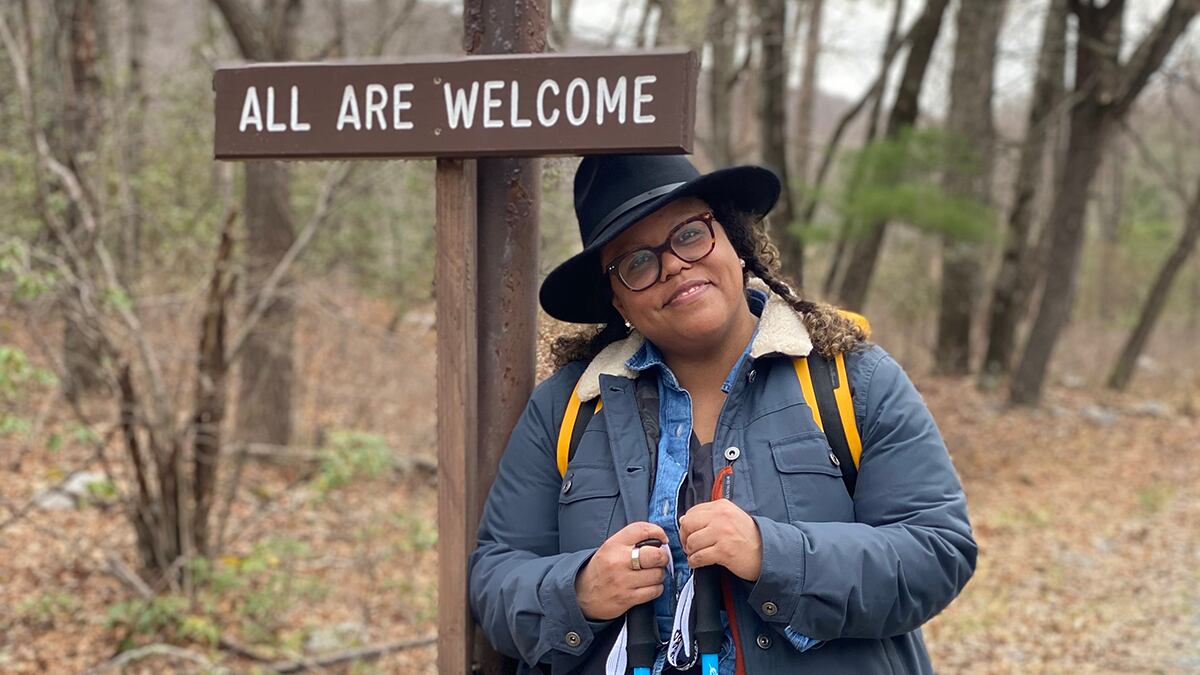Something happened to Kisha Jarrett in Iceland. In 2019, while fulfilling a lifelong dream to visit Reykjavik, the New York filmmaker scaled a glacier. She remembers her guides handing her a pair of clamps for her boots, a harness, and an ice ax, and sending her on her way.
“I got to the top and I felt like the king of the world, champion of all things,” Jarrett remembers.
That feeling was new for a woman who had been diagnosed with lupus in 2016 and struggling with chronic pain from the disease for years. Jarrett, who was living in Portland at the time, returned home from Reykjavik hungry for her next adventure. The experience inspired her documentary Black Girl in the Woods, about her experience hiking as a Black woman with lupus.
“For the most part, people don’t understand what lupus is, or if they do, they don’t understand the level of pain we’re in,” Jarrett says. “People with lupus, we manage pain all the time. We often don’t even tell people we’re in pain until it gets to, like, a 10.”
After spending so much time alienated from her body, Jarrett came home from Iceland ready to seek out new forms of movement, particularly hiking. It was a transformation that had already been in the works when she moved to Portland.
“I bought a Jeep and became the kind of person who goes on waterfall hikes,” she quips. After scaling the glacier, she began hiking more seriously. She adjusted to a more active, outdoorsy lifestyle after years of being shut off from the part of herself that loved to move.
Jarrett grew up in Virginia, where she was a competitive cheerleader and a gymnast, in addition to playing soccer and softball. She approached Black Girl in the Woods eager to be an athlete again.
“I was in so much pain,” she says. “A body that is not in motion does not stay in motion. You start to lose all of that. All of these touchstones I had about myself—I was this athlete—I couldn’t do that stuff anymore. So when I [climbed the glacier] I was like, this is the thing I remember.”
By the summer of 2021, Jarrett had set her sights on a new challenge: the Pacific Northwest Trail, which runs through Montana, Idaho and Washington, straddling the Canadian border.
It’s not to be confused with the Pacific Crest Trail, which runs the length of the West Coast from Canada to Mexico and was the subject of Cheryl Strayed’s 2012 memoir Wild. The 1,200-mile Pacific Northwest Trail is less popular than the PCT, attracting only about 50 thru-hikers per year, compared to the roughly 700 to 800 people who attempt the PCT annually.
Jarrett, a lifelong artist, decided she would turn the experience into a feature-length film. As a Black woman, she had a feeling her story would resonate with viewers who weren’t used to being represented in media about thru-hikers, who bring all of their equipment with them on their backs and complete trails from start to finish, sometimes enduring hundreds or thousands of miles of hiking.
Jarrett wanted to reach people of color who love the outdoors but have shied away from pursuing their passion. “Walking into REI as a person of color is hella intimidating,” she says.
She believes many people of color don’t realize the resources available to them: “Even if someone [at the store] is nice and polite, it’s like, ‘Oh, wait, I can just go up to somebody and they’ll fit me for a pack?’ The intimidation starts outside the store.”
The shape of the documentary shifted completely when Jarrett arrived at the Pacific Northwest Trail. On her first day of hiking, she tore the tendons in both of her feet. The injuries dashed her hopes for that year—she would have to wear orthopedic boots on both feet for eight weeks and undergo eight more weeks of physical therapy to recover.
The injury also forced Jarrett to reconsider her approach to the documentary altogether. She found herself reflecting on her motives, the ways she might have been forcing herself into a mold better suited for hikers who weren’t dealing with chronic health issues.
“I failed spectacularly, no doubt about it. I absolutely did,” she says, laughing. “But at the same time, it raised this question: Why am I trying to fit myself into this measure of success? I have an autoimmune disease that prevents me from doing things in the same way that other people do them.”
Now, Jarrett is retooling Black Girl in the Woods. The film will focus more generally on Black hikers and hikers with chronic illness, and she plans to take a broader, more holistic approach to telling their stories.
Jarrett is still hiking, but for now she’s set aside thru-hiking. Instead, she’s making sure the film takes into account the needs of her body. She wants to send the message that success for hikers with chronic illness can be on their own terms, and it might look a little different from success for other hikers.
This summer, Jarrett plans to walk part of the Camino in the U.K. So the journey of Black Girl in the Woods—her journey into nature and back into alignment with her own body—will continue.
“Why does success have to be that you got to the summit?” she asks. “Why can’t success be that you saw the sights, you did the thing?”
Read about all Five filmmakers who are reshaping the cinema of the Pacific Northwest here!
